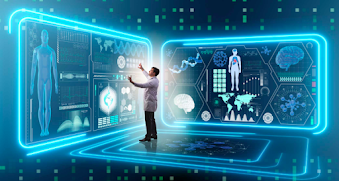Artificial intelligence (AI) has the potential to significantly enhance emergency healthcare by improving efficiency, accuracy, and patient outcomes. Here are some ways AI can be applied in healthcare emergencies:
- Early detection and prediction: AI algorithms can analyse large volumes of patient data, including vital signs, medical records, and lab results, to detect early warning signs of emergencies such as sepsis, heart attacks, or strokes. By identifying these conditions early, AI can help healthcare providers intervene sooner and potentially prevent complications.
Decision support systems: During emergencies, healthcare professionals often face time-critical decisions. AI-powered decision support systems can assist by providing real-time recommendations based on patient data and evidence-based guidelines. These systems can help prioritise patient triage, suggest appropriate treatment options, and guide medical interventions.
Image analysis: AI can analyse medical images, such as X-rays, CT scans, and MRIs, to assist in the diagnosis of emergencies like traumatic injuries, brain haemorrhages, or pulmonary embolisms. AI algorithms can rapidly identify abnormalities or highlight critical areas, enabling radiologists and emergency physicians to make faster and more accurate assessments.
Natural language processing: AI can process and extract relevant information from clinical notes, medical literature, and emergency medical service (EMS) reports. This capability can assist in extracting critical details, identifying risk factors, or alerting healthcare providers to relevant patient history, ultimately aiding in the decision-making process.
Robotics and automation: In emergency situations, AI-powered robots and automation systems can assist healthcare professionals in tasks such as patient monitoring, drug administration, and repetitive procedures. These technologies can help alleviate the workload on healthcare providers and ensure consistent and accurate care.
Resource allocation: AI algorithms can analyse real-time data on bed availability, staffing levels, and equipment availability to optimise resource allocation during emergencies. This can help hospitals and emergency departments efficiently manage their resources and ensure timely care for patients in critical condition.
Tele-medicine and remote monitoring: AI can support Tele medicine platforms by analysing patient data transmitted from remote locations. For example, wearable devices can continuously monitor vital signs and send real-time data to AI algorithms that can identify abnormal patterns and trigger alerts for further assessment by healthcare providers.
Data-driven insights: AI can analyse vast amounts of healthcare data, including electronic health records, population health data, and public health databases, to identify patterns, risk factors, and trends related to emergencies. These insights can aid in public health planning, resource allocation, and early intervention strategies.
However, it's important to note that while AI shows great promise in healthcare emergencies, it should be seen as a tool to augment human expertise and not as a replacement for healthcare professionals. Ethical considerations, data privacy, and regulatory frameworks also need to be addressed to ensure the responsible and safe use of AI in healthcare emergencies.














